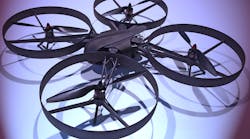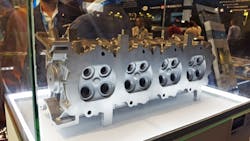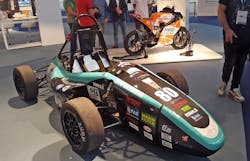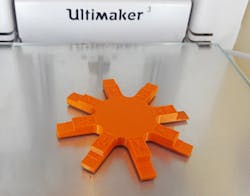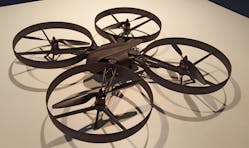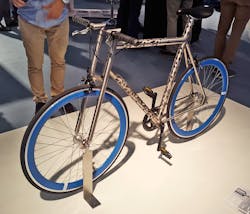Fira de Barcelona—Barcelona’s Industry Week—was the site of around 850 international speakers and more than 50,000 professionals exhibiting innovative technology from around the globe. The event brought together many things, but this particular list is about 3D printing. Lots of processes, research, and new printers were on display, and here is just a short list of the exhibitions.
1. Valve Block from Comher
Aluminum silicon alloy AlSi 10mg was used in a selective laser melting SLM 500 machine. The build space is imperative for large parts like this. The SLM 500 provides a build envelope of 500 × 280 × 365 mm³. It also has multiple beams for faster printing. This valve block took 6 days, 22 hours, and 30 mins to produce. With four fiber lasers (4× 400 W or 4× 700 W) working simultaneously the build rate was increased up to 90% compared with the twin configuration (2× 400 W or 2× 700 W).
2. Student Engineering
3D printing is showing up more in student races. Sometimes it is to make parts lighter, but many times it can be a time-saving way to make the complex shapes of the body and fairings. This can also give students a chance to test new aerodynamics design with faster interations. I’ve seen a couple teams experimenting with minor load bearing pieces, too. This image shows an SAE Formula One car and a Moto-e electric motorcycle.
The SAE Formula One international program is a design competition for grad and undergraduate students. The competition has a fictional manufacturing company contract students to develop a small formula one car. There are a series of rules they must follow in developing a prototype. The car is inspected and judged on a number of on track performance tests.
In the background is a Moto-e bike, which features a similar concept, only with an electric motorcycle. One of the biggest differences here is that a student isn’t able to race the prototype. A certified driver is required for safety reasons.
3. Natural Robotics
Using a CO2 laser instead of a YAG fiber, Natural Robotics showed off how it is able to selectively laser sinter (SLS) light and white colored powders. Some SLS printers are limited to darker powders to absorb the lasers energy to properly sinter. This is a new direction for the company that previously used lasers in cutting and engraving. Already familiar with CO2 lasers, the engineers saw some benefits of using it for 3D printing over a traditionally used YAG fiber laser. Launched on Kickstarter on Oct. 24th, Natural Robotics’ new 3D printer will add new capabilities for the SLS process.
4. Gages and Tooling
While some still think 3D printing in extruded plastic is for prototyping and Makers, companies like Volkswagen are saving time and money by printing out gages like this one. A simple gap gage lets workers make sure windows and doors are installed correctly and uniformly.
5. Sigma
BCN3D recently released this extruded plastic printer. With two heads, users can use two colors or materials in a design. Some companies have used the ability to change colors to print parts with wear marks. It also allows a part to be printed with a support material that is dissolvable in water. This allows for sharper angles and cantilevered surfaces.
6. Aitiip Technology Center
The wheel and swing arm of a motorcycle made with fused deposition modeling (FDM) technology was used to validate a design. A motorcycle developed by EUPTBikes team and printed in Aitiip Technology Centre won the competition and several awards in the contest celebrated in Motorland (Aragon, Spain) in September 2016. Made with Ultem 9085, the design let engineers unmount fairing in 11 seconds and change batteries in 5, without having turning off the motorcycle.
7. Carbon Fiber
HP had many things on display, but relatively speaking, you don’t see a lot of carbon fiber 3D printing. This drone uses the strength of carbon fiber and the ability of changing densities to make strong lightweight structures. Many of the parts are also undergoing further light weighting by minimizing fill using lattice structures.
8 Trumpf
At first this looked like a cool 3D-printed bike, but in fact it was laser cut in a subtractive process. Still, it looked interesting, so it was included. TruBike is a fully functioning laser-cut bike with a metal tube frame. It was created by Eleventwentyseven for Trumpf Spain and was produced using a TruLaser Tube 7000. The TruLaser 7000 can cut up to a 10-in. diameter and thicknesses up to 0.4 in. for mild steel.
